
Custer's Last Stand, subtitled "The Battle of Little Big Horn, June 25, 1876", is a board wargame published by Battleline in 1976 that simulates the Battle of the Little Big Horn.

Custer's Last Stand, subtitled "The Battle of Little Big Horn, June 25, 1876", is a board wargame published by Battleline in 1976 that simulates the Battle of the Little Big Horn.
In June 1876, as General George Custer and his 7th Cavalry Regiment approached a large encampment of Lakota Sioux, Northern Cheyenne, and Arapaho on the Little Big Horn River, he divided the regiment into three groups. As Custer advanced with only his group, a large force of native warriors under Sitting Bull and Crazy Horse attacked and annihilated Custer and his men. [1]
Little Big Horn is a 2-player wargame in which one player controls the forces of Custer, and the other player controls the native forces. [2] The game includes 120 die-cut counters and an 8-page rulebook. On a complexity scale of 1–10, game critic Jon Freeman rated it a relatively complex 8. [3]
The game begins as Custer approaches some native encampments. Game critic Nick Palmer summarizes what follows as "When they spot each other, Custer sends off a 'runner' to get reinforcements, and the camps start to stir uneasily. Custer can choose to hang about waiting for powerful reinforcements, or he can make an immediate foray, with the chance of some victory points but a very grave danger of repeating history." [4]
The game provides some optional "what if?" rules: What if Custer's force had been armed with Gatling guns or field artillery? What if Custer's reinforcements had arrived on time? What if Custer had brought his ammunition wagons with him? [3]
This battle had already been simulated in The Battle of the Little Big Horn published by Waddingtons in 1962. But in 1976, the centennial of the battle, three small companies debuted new games about the battle at Origins II: 7th Cavalry by Attack Wargaming Association; Little Big Horn: Custer's Last Stand by TSR, and Custer's Last Stand by Battleline. [5]
Battleline, a small games company that had created and developed all of their previous games in-house, instead bought and published a game that had been created and developed by freelancer Richard Zalud. [2]
Battline's game did not sell well; neither did the two competing games introduced at Origins. As Gary Gygax, designer of TSR's rival game, recalled, "Of course, all three companies suffered sales-wise, as interested gamers were divided." [6]
In Issue 28 of Moves (August/September 1976), game designer Richard Berg called the components and rules "Physically quite professional [...] and mechanically quite simple." But he called the game nothing more than "a modular version of hide and seek." And he questioned the attempt to turn a one-sided massacre into a balanced game, saying, "There seems to be a lot of effort expended in making the situation gameable, but the result is only partially successful." He concluded, "The game does not hang together well enough to justify the design. [...] It will appeal mostly to collectors and afficionados of the period." [2] *
In his 1977 book The Comprehensive Guide to Board Wargaming , Nick Palmer commented "Interesting choice of strategies, but some rule problems." [4]
In the 1980 book The Complete Book of Wargames , game designer Jon Freeman questioned the replayability of the game, commenting, "The game is not badly done, but the situation is worth about one play; after that it becomes a bit stale." He also questioned making a game from such a lop-sided battle, and gave the game an Overall Presentation of only "Fair", saying, "The treatment [...] is probably as good as could be expected, but the situation itself is so bad that it drags the game down. A curious but stolid affair." [3]
In The Guide to Simulations/Games for Education and Training, Martin Campion questioned the rules that deliberately warped historical accuracy, saying, "The game is faithful, not to what happened, but to what should have happened. A more historical problem could be created by requiring Custer to be at least moderately aggressive." [7]
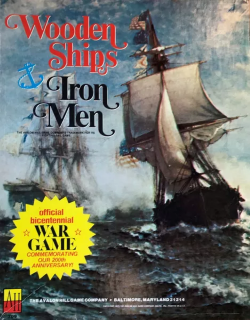
Wooden Ships and Iron Men is a naval board wargame simulating naval combat during the Age of Sail that was published by Battleline Publications in 1974, then revised and republished by Avalon Hill the following year.
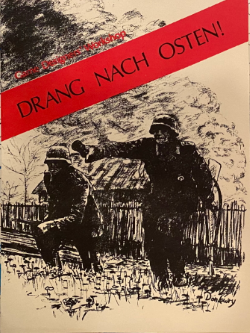
Drang Nach Osten! is a monster board wargame published in 1973 by Game Designers' Workshop (GDW) that simulates Operation Barbarossa, the German invasion of the Soviet Union in 1941. The game was the first of what was envisioned as a series of games with identical wargame rules and map scale that would simulate the entire Second World War in Europe.
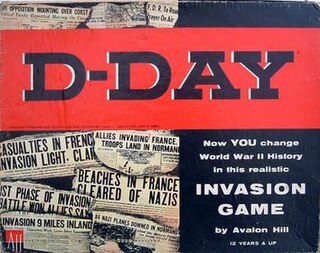
D-Day is a board wargame published by Avalon Hill in 1961 that simulates the six months of the European Campaign of World War II from the Normandy Invasion to the crossing of the Rhine. It was the first wargame to feature the now ubiquitous hex grid map and cardboard counters, and was revised and re-released in 1962, 1965, 1971, 1977 and 1991.

Afrika Korps is a board wargame published by Avalon Hill in 1964 and re-released in 1965 and 1978 that simulates the North Africa Campaign during World War II.

The Arab-Israeli Wars, subtitled "Tank Battles in the Mideast 1956–73", is a board wargame published by Avalon Hill in 1977 that simulates various battles during the Suez Crisis, Six-Day War and Yom Kippur War.

Alexander the Great is a board wargame first published by Guidon Games in 1971 that simulates the Battle of Arbela in 331 BCE, also known as the Battle of Gaugamela. A revised edition was published by Avalon Hill in 1974. Both editions of the game were notable for having what one critic described as "one of the ugliest maps ever to curse a war game."
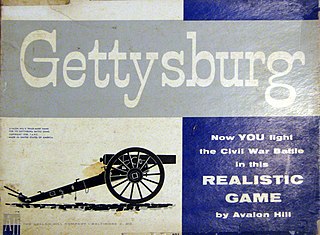
Gettysburg is a board wargame produced by Avalon Hill in 1958 that re-enacts the American Civil War battle of Gettysburg. The game rules were groundbreaking in several respects, and the game, revised several times, was a bestseller for Avalon Hill for several decades.
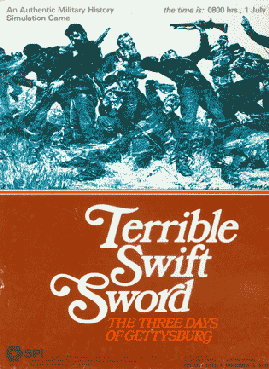
Terrible Swift Sword: Battle of Gettysburg Game is a grand tactical regimental level board wargame published by Simulations Publications, Inc. (SPI) in 1976 that simulates the Battle of Gettysburg during the American Civil War. A second edition was published by TSR in 1986.

Panzergruppe Guderian is a board wargame published by Simulations Publications, Inc. in 1976 that simulates the 1941 Battle of Smolensk during World War II.

Little Big Horn: Custer's Last Stand is a wargame published by TSR in 1976 that simulates the Battle of Little Big Horn.
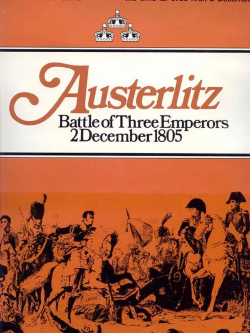
Austerlitz, subtitled "The Battle of Three Emperors, 2 December 1805", is a board wargame published by Simulations Publications Inc. (SPI) in 1972 that simulates the Battle of Austerlitz between Napoleon's French forces, and the Austrian-Russian forces of the Third Coalition.

Fury in the West is a board wargame published by Battleline in 1977 that simulates the Battle of Shiloh during the American Civil War. It used several new rules that were unique at the time, but received mixed reviews.

Spitfire, subtitled "Tactical Aerial Combat in Europe 1939-42", is a board wargame published by Simulations Publications Inc. (SPI) in 1973 that simulates aerial combat during World War II.
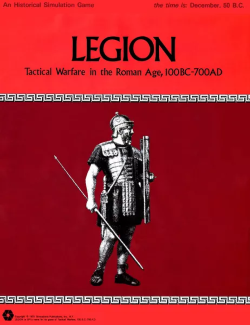
Legion: Tactical Warfare in the Roman Age, 100BC-700AD is a board wargame published by Simulations Publications, Inc. (SPI) in 1975 that simulates battles involving Roman legions against a variety of historical foes. Originally published by SPI as Centurion, the game was revised and republished with the title Legion as part of a series called PRESTAGS.
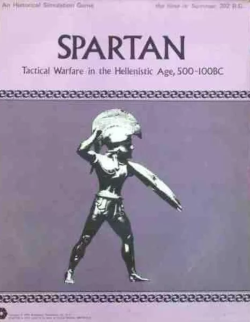
Spartan: Tactical Warfare in the Hellenistic Age, 500-100BC is a board wargame published by Simulations Publications, Inc. (SPI) in 1975 that simulates battles during the rise of Greece to the period of Roman rule. Originally published by SPI as Phalanx, the game was revised and republished with the title Spartan as part of a series called PRESTAGS.

7th Cavalry is a board wargame published by Attack Wargaming Association (AWA) in 1976 that simulates the Battle of Little Big Horn. Published on the centenary of the battle, the game had two other rival games about the same battle introduced at the same games fair, and as a result, none of the games sold well. In addition, critics found this game's rules too simple, and not well written.
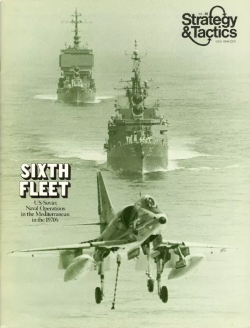
Sixth Fleet, subtitled "US/Soviet Naval Warfare in the Mediterranean in the 1970s", is a board wargame published by Simulations Publications Inc. (SPI) in 1975 that simulates a hypothetical attack against NATO forces in the Mediterranean Sea by naval forces of the Soviet Union. The game did not sell well, and several critics found that the tactics used in the game more closely resembled Napoleonic land battles rather than naval warfare in the 1970s.

Submarine is a board wargame published by Battleline Publications in 1976 that simulates submarine warfare during World War II. The following year, Avalon Hill bought the rights to the game, expanded the rules and republished it with new cover art.
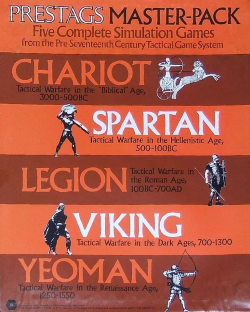
PRESTAGS is a collection of five board wargames published by Simulations Publications, Inc. (SPI) in 1975 that simulates battles from the Bronze Age to the Renaissance. The five games were originally published as individual games with their own set of rules before being collected into one box and their various rules revised to produce one common set of rules.
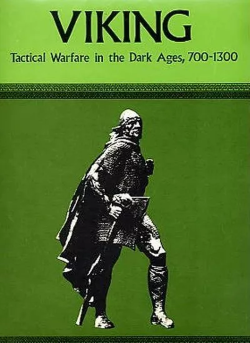
Viking, subtitled "Tactical Warfare in the Dark Ages, 700-1300", is a board wargame published by Simulations Publications, Inc. (SPI) in 1975 that simulates battles in Europe and the Middle East during the Medieval period. Originally published by SPI as Dark Ages, the game was revised and republished with the title Viking as part of a collection of games called PRESTAGS.